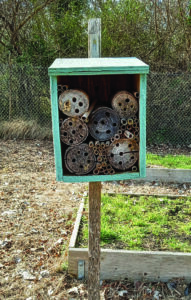
A native bee hotel like this one at the Cambridge Community Garden at Waugh Chapel offers refuge to many of the solitary native bee species that add biodiversity to conservation areas and help pollinate plants in gardens. (Photo by Debra R. Messick)
Have you ever seen a native bee hotel? Hint: It isn’t shaped anything like a hive, and there’s not a drop of honey.
But if you spot a structure resembling an open-faced bird house filled with circular nooks and crannies, you may have arrived at one without knowing it.
Emily Zobel, University of Maryland Extension entomologist and agriculture educator for Dorchester County, has several of her own, and can explain the reasons behind the unique design.
According to the United States Geological Survey, honey bees were originally imported from Europe in the 17th century. Honey bees, who now help pollinate numerous crops nationwide, like fruits and nuts, have had their own natural habitat greatly reduced, causing great concern and calls to action.
However, while important in the pollination of some crops, honey bees are also significant competitors of native bees and the USGS advises they should not be introduced in conservation areas, parks, or areas where you want to foster the conservation of native plants and native bees.
The Xerxes Society for Invertebrate Conservation, which works to preserve native pollinators, agrees, stating that the 4,000 native bee species across the U.S. actually comprise “the most important group of pollinators” for the environment as a whole.
According to Zobel, most of the characteristics people readily associate with bees don’t apply at all to Mason, Carpenter, Leafcutter, Miner, and others of the 400 or so species native to Maryland.
Unlike communal honeybees, native bees are solitary, building individual nesting compartments. With no hive to defend, they’re far less aggressive and prone to stinging, she said.
Female native bees collect protein rich pollen and nectar to prepare protected individual cocoon-type brooding cells for laying eggs, where the pupae can grow until emerging in the spring.
While 70 percent of native bees will nest in ground burrows, a crucial number of others will inhabit suitable natural spaces, such as old beetle tunnels in logs or tree stumps, or hollow stems found in bamboo, reeds and other plant stems.
Replicating the hollow stem scenario is the reason behind the distinctive native bee house design.
Because of the variety of sizes within the overall bee population it’s recommended to provide an array of hollow tube dimensions to best serve whichever are in the area. But, be sure one end of the tube is closed.
USDA’s publication Bee Basics recommends tying up a bunch of hollow twigs, for instance, elderberry, or using paper tubes or straws (not plastic, though; bees won’t use them), or packing them within a small milk carton, being sure to place them horizontally, facing south or southeast.
Zobel said she has had success using aluminum cans stacked in bins on her porch, keeping them out of the wind, weather and her own comings and goings.
While the structures can be reused, cleaning them out periodically is crucial.
“Think about how you would feel, coming to a hotel room which hadn’t had maid service in a few years,” she laughed.
It’s also a good idea to safely sanitize the tubes, if possible, once a year with a weak bleach solution. Paper tubes can be thrown away and bamboo tubes can be recycled, she added. (Usually you can find people eager to keep the voraciously spreading invasive in check by offering surplus bamboo on Craigslist, Zobel said.
Zobel suggested that having at least two bee houses, with one available to use while the other is being cleaned of mold, mud and debris is optimal.
“But taking that first step and making even one is still very helpful,” she noted.
Two additional steps can benefit the overall efforts of creating a native bee nesting residence. First, have an emergent box which receives some light on hand in the spring as a transitional spot for young bees to begin coming out of their enclosures.
Also, a supply of early blooming native flora nearby helps ensure that your garden remains a hospitable native bee habitat.



